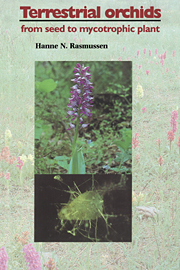Book contents
- Frontmatter
- Contents
- Acknowledgements
- Introduction
- 1 Properties of ‘dust’ seeds
- 2 Seed development
- 3 Seed survival
- 4 Requirements for germination
- 5 Fungi
- 6 Germination processes
- 7 Underground organs
- 8 Orchid mycorrhiza
- 9 Abiotic factors in growth and development
- 10 Life history and phenology
- 11 Propagation
- 12 Effects of orchid mycorrhiza
- 13 Descriptions of genera
- Appendix A Nutrient substrates mentioned in the text
- Appendix B Names and synonyms
- References
- Index
3 - Seed survival
Published online by Cambridge University Press: 13 October 2009
- Frontmatter
- Contents
- Acknowledgements
- Introduction
- 1 Properties of ‘dust’ seeds
- 2 Seed development
- 3 Seed survival
- 4 Requirements for germination
- 5 Fungi
- 6 Germination processes
- 7 Underground organs
- 8 Orchid mycorrhiza
- 9 Abiotic factors in growth and development
- 10 Life history and phenology
- 11 Propagation
- 12 Effects of orchid mycorrhiza
- 13 Descriptions of genera
- Appendix A Nutrient substrates mentioned in the text
- Appendix B Names and synonyms
- References
- Index
Summary
Time of germination
In field sowing experiments performed in Maryland, USA, I observed the first signs of germination in Goodyera pubescens at the beginning of May, i.e. in spring, and in Galearis spectabilis and Corallorhiza odontorhiza at the beginning of June (Rasmussen & Whigham, 1993). The seeds had been harvested during the previous autumn and sown in November.
All other evidence on germination in situ is based on observations made at various times of the year of seedlings that were assumed to be young, although their exact age could not be determined. Casual observations of single protocorms are almost without value, but more reliable data are available from year-round studies of a given population which allow the size distribution of seedlings at different seasons to be compared. The general impression is that most of the holarctic species germinate in spring (Table 3.1). Ames (1922) found young seedlings of the American species Goodyera pubescens in spring, which agrees with my own observations from field sowings, and seedlings of many European taxa have also been found in spring, exceptions being some species of Dactylorhiza, Orchis, Himantoglossum, Spiranthes, Epipogium and Corallorhiza, the young seedlings of which were dug up in late summer or autumn (Table 3.1; see also Chapter 13).
A very large proportion of the holarctic species, except for those mentioned in Table 3.1, have not been recorded as protocorms in nature. A wider application of the field sowing technique that has recently been described (Rasmussen & Whigham, 1993) should yield more information on when seeds germinate and how rapidly the seedlings develop under near-natural conditions.
- Type
- Chapter
- Information
- Terrestrial OrchidsFrom Seed to Mycotrophic Plant, pp. 28 - 38Publisher: Cambridge University PressPrint publication year: 1995
- 1
- Cited by



